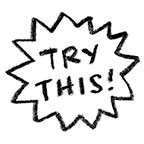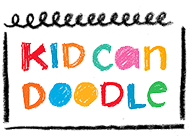
In this series, Awesome Artists, we talk to our favorite artists to find out their techniques, learn how they do things, and get their tips for creating. We spoke to Kirsten Ulve to get pointers on sketching people, and Allison Langton, who shared her process on painting plants in watercolor. Today we get a behind-the-scenes look at creating a picture book as we chat to Tim Miller, who brought Snappsy the Alligator (words by Julie Falatko) to life (even though he didn’t ask to be!)
Meet Awesome Artist Tim Miller
Above (from left to right) are Tim Miller’s sketch, color study, and final cover art with typesetting.
It’s such a treat to see these process images, because we usually only see the final art and it’s so easy to focus on how ‘perfect’ they are. It’s important to know that there are many steps to get to the final art. Nearly all professional artists begin with sketches, the rough ideas that we all make — the ‘doodles.’ I want to demystify the process of making beautiful pictures, but I also want to show how much time and love actually goes into creating these wonderful illustrated books.
KCD: Hi Tim. Thanks for stopping by and sharing your work with us! Can you tell us how do ideas come to you?
TM: The inspiration for my work simply comes from a very mundane knee-jerk response to some sort of external stimulus in the world that strikes a chord with me. (For example, the first time I encountered Julie Falatko’s Snappsy the Alligator, mental images came to mind as I read the story — and those mental pictures became the foundation to build upon.) When I begin to sketch an idea, I try to draw what I’m seeing in my mind as best I can, but it’s not always clear. Usually, it becomes clearer only after I make several rough sketches. I continue to refine the concept until I land on something that feels solid.
I think of the process as trying to make out something in the fog. It’s difficult when you’re far away, but as you draw nearer, the details become more distinguishable. A key part of the process, though, is that I have to be entertained. There has to be a good personal motivation in it to lure me forward.
Tim Miller shows How To Doodle Snappsy in this video:
Snappsy Did Not Ask to Be in This Video About How to Draw Him from Tim Miller on Vimeo.
 Note that Tim sketches with a brush. There’s a loose, fluid quality to the doodle that the ink and brush gives, with variation in the line width and opacity.
Note that Tim sketches with a brush. There’s a loose, fluid quality to the doodle that the ink and brush gives, with variation in the line width and opacity.
 How many shapes does he use? Try drawing Snappsy as Tim demonstrates with a brush, then create your own character with only one or two shapes, such as ovals/circles or squares/rectangles.
How many shapes does he use? Try drawing Snappsy as Tim demonstrates with a brush, then create your own character with only one or two shapes, such as ovals/circles or squares/rectangles.
KCD: Can you show us your process for creating the art for the book?
TM: One of my favorite scenes to draw in Julie Falatko‘s Snappsy the Alligator (Did Not Ask to Be in This Book) is when Snappsy throws a party. I drew my first sketch directly on the manuscript to make note of the first idea that came to mind when I read it.
Next, I used that rough thumbnail as a starting point to fill out the scene a little more, giving a better sense of space & atmosphere.
Then, I began to tighten up the drawing to see things more clearly making some edits here and there to tweak the overall composition.
I went back at it again with minor adjustments after sharing my roughs with my Art Director Denise Cronin and Editor Joanna Cardenas. The donkey by the door was reading too much like Snappsy (which I knew they were going to say but I really like drawing him), so they asked me to turn it into a different character which is how the weird dog poodle thing came to be. I was also still working out the final look for Snappsy so you can see him changing here too.
Then it came time to figure out the colors, so I did a rough color sketch. It took me awhile to figure out what color would be good for the interior of Snappsy’s house. I needed something that complimented his green without overpowering him. From there, I tried to settle on a festive palette of party hats, balloons, and streamers that popped but also balanced with rest.
For the finish, first I redrew everything in separate peieces with brush and ink and added watercolor to the drawings. Then, I scanned everything in and pieced it together on the computer adjusting all the colors digitally.
And finally two minutes before everything needed to go to the printer, things landed here:
 See how important it is to work out details in your drawing in a loose sketch first? There’s quite a few drafts before getting to the final art.
See how important it is to work out details in your drawing in a loose sketch first? There’s quite a few drafts before getting to the final art.
Below watch the book trailer that Snappsy did NOT ask to be in:
“Nope,” says Snappsy.
Snappsy the Alligator (Did Not Ask to Be in This Book) words by Julie Falatko, pictures by Tim Miller, published by Penguin Random House.
***
Tim Miller is an author and illustrator based in New York City. His own Moo Moo in a Tutu, published by Balzer & Bray debuts in early 2017.
 Compose your next work of art by planning it out first. Sketch a few different ideas, or perspectives/viewpoints of the subject. Before adding color, consider your palette, play with different combinations, and decide your final medium: colored pencils, watercolors or perhaps acrylic paint. You may not do this with every drawing, but when you’re working on something you want to keep, the early prep will help make the final color work much more enjoyable.
Compose your next work of art by planning it out first. Sketch a few different ideas, or perspectives/viewpoints of the subject. Before adding color, consider your palette, play with different combinations, and decide your final medium: colored pencils, watercolors or perhaps acrylic paint. You may not do this with every drawing, but when you’re working on something you want to keep, the early prep will help make the final color work much more enjoyable.
All images courtesy of Tim Miller.
Follow my blog with Bloglovin














